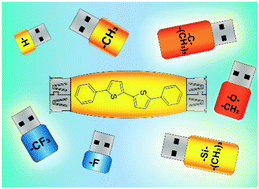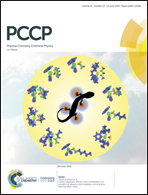Impact of terminal substituents on the electronic, vibrational and optical properties of thiophene–phenylene co-oligomers†
Abstract
Owing to the combination of efficient charge transport and bright luminescence, thiophene–phenylene co-oligomers (TPCOs) are promising materials for organic light-emitting devices such as diodes, transistors and lasers. The synthetic flexibility of TPCOs enables facile tuning of their properties. In this study, we address the effect of various electron-donating and electron-withdrawing symmetric terminal substituents (fluorine, methyl, trifluoromethyl, methoxy, tert-butyl, and trimethylsilyl) on frontier orbitals, charge distribution, static polarizabilities, molecular vibrations, bandgaps and photoluminescence quantum yields of 5,5′-diphenyl-2,2′-bithiophene (PTTP). By combining DFT calculations with cyclic voltammetry and absorption, photoluminescence, and Raman spectroscopies, we show that symmetric terminal substitution tunes the highest occupied molecular orbital (HOMO) and the lowest unoccupied molecular orbital (LUMO) energies of TPCOs within a range of ∼0.7 eV, shifts the frequencies of the vibrational modes associated with the phenyl rings, changes the photoluminescence quantum yield by about two-fold and slightly changes the bandgap by ∼0.1 eV. We demonstrate that these effects are governed by two factors: the Hammet constant of the substituents and their involvement in the π-conjugation/hyperconjugation described by the effective conjugation length of the substituted oligomer. A detailed picture underlying the effect of the terminal substituents on the electronic, vibrational and optical properties of TPCOs is presented. Overall, the unraveled relationships between the structure and the properties of the substituted PTTPs should facilitate a rational design of π-conjugated (co-)oligomers for efficient organic optoelectronic devices.



 Please wait while we load your content...
Please wait while we load your content...